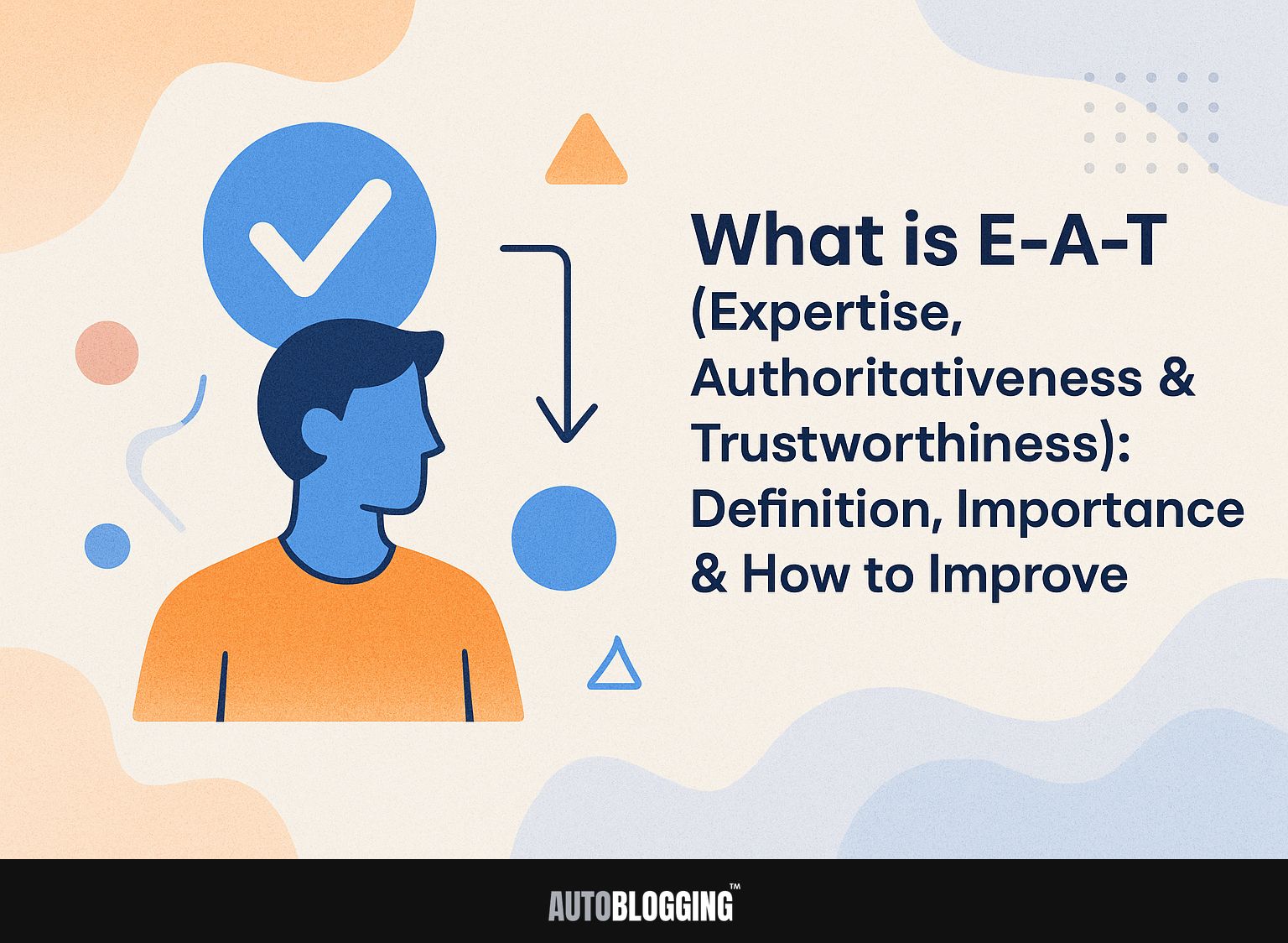
To succeed online, you need to know E-A-T-Expertise, Authoritativeness, and Trustworthiness. Google’s Quality Raters emphasize E-A-T as a key factor in assessing content quality. This article will explain what E-A-T is, why it is important, and give practical tips to improve your online presence. Improve the trustworthiness of your content and boost your search rankings by learning these key principles of E-E-A-T!
Key Takeaways:
- E-A-T is an important factor in SEO, as it can impact search rankings, user experience, and brand reputation.
- Knowledge, credibility, and trustworthiness are important for E-A-T. You can improve these by creating high-quality content, showing your credentials, engaging with your audience, and incorporating user feedback.
- Gaining the trust of your audience is important for boosting E-A-T. This can be done by frequently updating content, demonstrating knowledge in different areas, and focusing on credibility and openness.
Contents
1. Definition of E-A-T
E-A-T is defined by four key elements that guide content creators in establishing credibility and trust with users and search engines alike. These elements are Skill, Authority, Trust, and Experience.
Healthline is notable because its articles are written by certified health professionals, which makes the information accurate and reliable. WebMD further emphasizes trustworthiness by incorporating extensive disclaimer sections and sourcing data from reputable studies.
To demonstrate E-A-T in your content, work with well-known experts in your area, reference reliable sources, and share your own experiences to make your content more relatable and genuine.
2. Components of E-A-T
The components of E-A-T are interlinked, each serving a specific role that contributes to the overall trustworthiness of a website. Experience means the direct knowledge the content creator has about a topic.
For instance, a physician writing about health topics should have clinical practice experience. Having formal qualifications indicates a high level of skill. A person with a doctorate can give detailed knowledge in their specialty.
Being an authority means being acknowledged by others in your field. This can be shown through references in academic journals or by being invited to give talks.
Trustworthiness focuses on reliability, where sites like Mayo Clinic or WebMD exemplify strong E-A-T by combining expert authorship with reputable information, ensuring a website’s credibility.
Importance of E-A-T in SEO
E-A-T is important for SEO, affecting search rankings and how users view the quality of content. As we navigate the complexities of search engine optimization, it is crucial to adapt to new technologies and practices. For those interested in deepening their understanding of SEO’s evolution, you might find value in our insights on emerging AI trends and the resilience of search strategies.
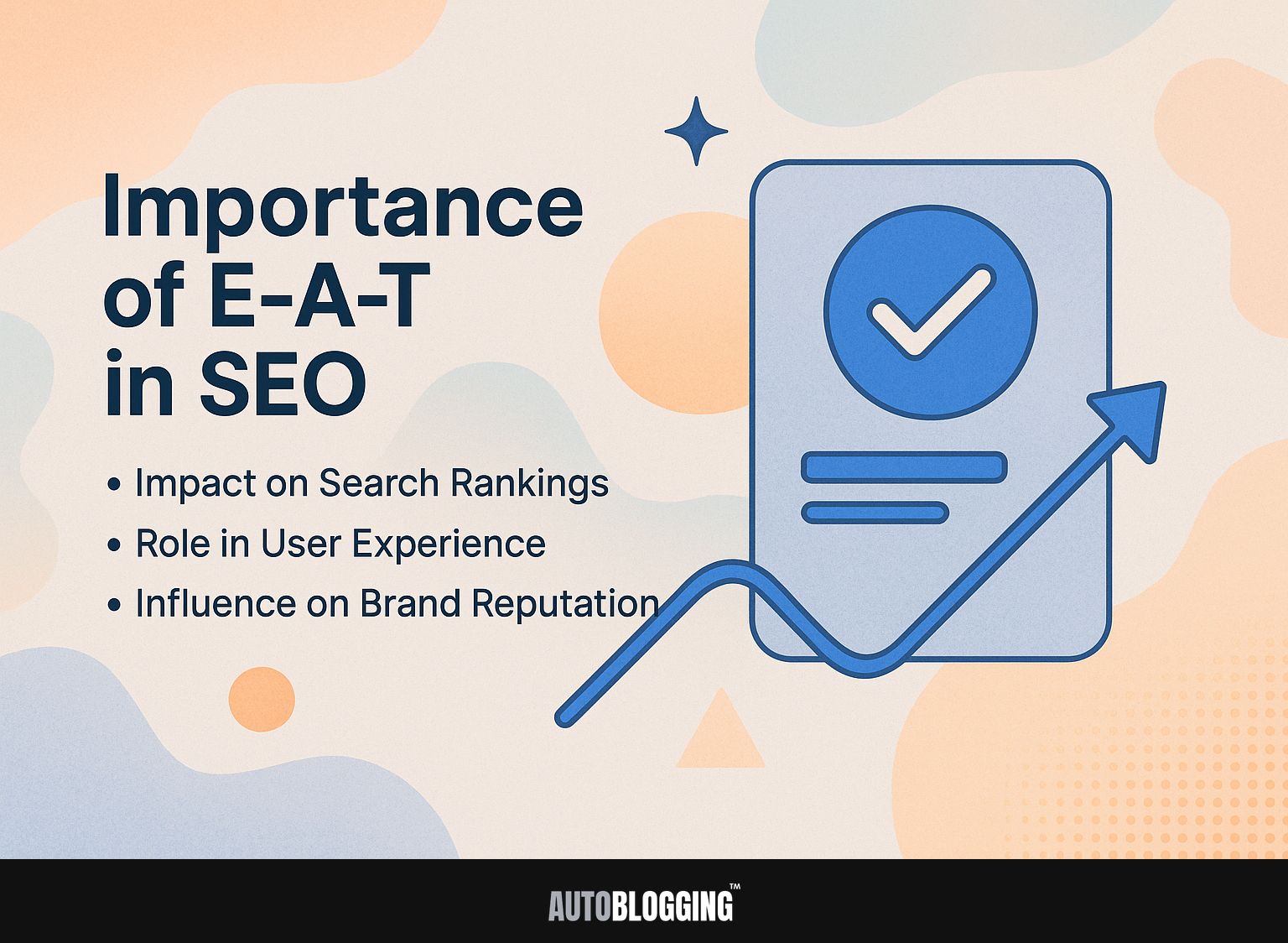
1. Impact on Search Rankings
High E-A-T scores correlate directly with improved search rankings, influencing Google’s algorithm to prioritize quality content.
To make your site more credible and trustworthy, write articles that are well-researched and backed by dependable sources.
For example, with Semrush, you can look at what your competitors have published to identify gaps in your own articles, ensuring you address a broader range of topics.
Google Analytics can help by identifying high-E-A-T articles that draw visitors and interactions; adjust your upcoming posts accordingly. Think about author bios that show qualifications to build trust, proving your knowledge and increasing reader confidence.
2. Role in User Experience
E-A-T improves user experience by building trust in the information given, which is important for YMYL (Your Money or Your Life) content. This approach directly correlates with improved engagement metrics.
For instance, improving E-A-T can lead to a 25% reduction in bounce rates and a 40% increase in average time on site. To use E-A-T well, make sure your content is created by trustworthy writers, supported by research, and refreshed often.
Feedback from users and opinions from specialists can greatly increase the impression of trustworthiness. By investing time in these areas, you build trust and increase user interaction, which drives more organic traffic.
3. Influence on Brand Reputation
Highlighting skill, authority, and reliability improves a brand’s reputation, encourages customer loyalty, and motivates users to write reviews and testimonials.
Patagonia is famous for its commitment to showing its green methods and skill in making outdoor wear. They connect with customers by sharing stories that show their dedication to being environmentally friendly. This helps build trust and motivates users to write reviews and share their experiences with Patagonia.
To improve your brand’s reputation, regularly show your knowledge with informative articles, share honest customer reviews, and be transparent about your business practices and principles. This thorough method can greatly improve how people see your brand.
Understanding Expertise
Being informed and capable is important for E-A-T because it demonstrates expertise and ability in the produced content. This approach has significant implications for content strategy-our framework for topic clustering demonstrates the practical application.
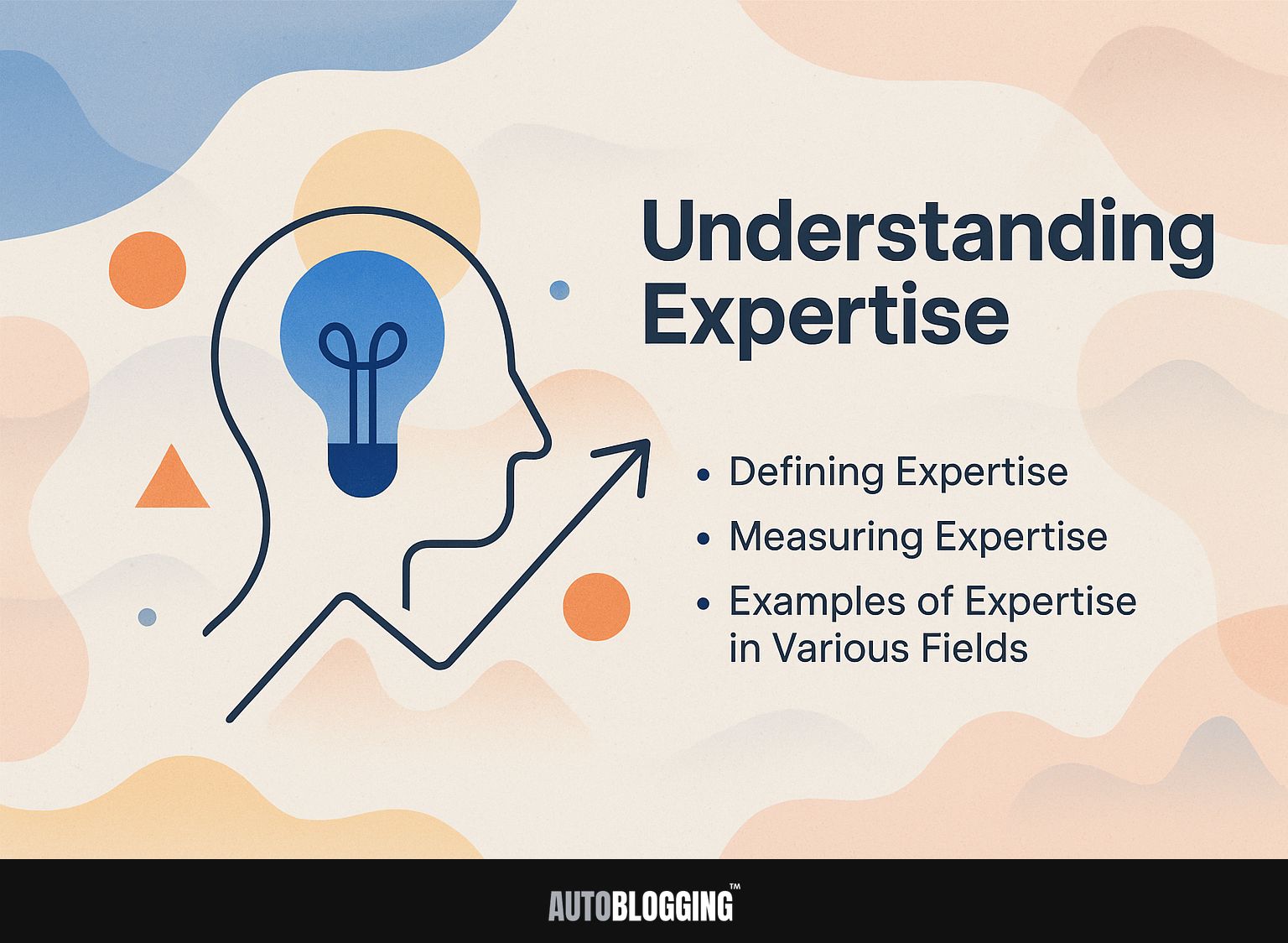
1. Defining Expertise
Being knowledgeable means showing you understand and can apply skills related to a specific topic in the information given to users.
To demonstrate your skills effectively, consider writing for well-known platforms like Forbes or Medium.
- First, identify a niche where you excel, such as digital marketing or data analytics.
- Next, put together a collection of your projects, focusing on your ideas and examples.
- When presenting ideas, highlight your original thoughts or current industry developments. For example, if you work in SEO, you might look into new methods for voice search optimization.
This proactive approach improves how people see you and builds your reputation in the field.
2. Measuring Expertise
One can measure skill by looking at the author’s qualifications, education, and the standard of their previous work.
To assess an author’s knowledge, look at their bios to see if they have degrees or certifications related to the topic.
Next, analyze past content performance using tools like BuzzSumo, which reveals metrics such as social shares and engagement.
Consider qualitative factors like industry reputation; high-quality articles often lead to backlinks from authoritative sources.
Look for feedback or recommendations that confirm their skills in the specific area. This method gives you a complete evaluation.
3. Examples of Expertise in Various Fields
Different areas have different levels of knowledge, especially in topics like health and finance.
Building trust in YMYL (Your Money or Your Life) areas is important. Brands like WebMD emphasize expert contributions by featuring licensed medical professionals as writers, ensuring content’s credibility.
Healthline follows suit, incorporating peer-reviewed research to back health advice. To increase your site’s credibility, think about adding interviews with experts or including content from well-known specialists.
Tools like SEMrush can be used to study the skills of competitors, while platforms like Help a Reporter Out (HARO) allow you to reach out to industry specialists for reliable contributions.
Reliable and clear information that focuses on being correct will increase your website’s credibility and keep users interested.
Understanding Authoritativeness
Being recognized as credible means a website or writer is trusted in their specific area, which affects how users trust and interact with them. For a deeper understanding of how external factors contribute to credibility, delving into off-page SEO strategies and their benefits can provide valuable insights.
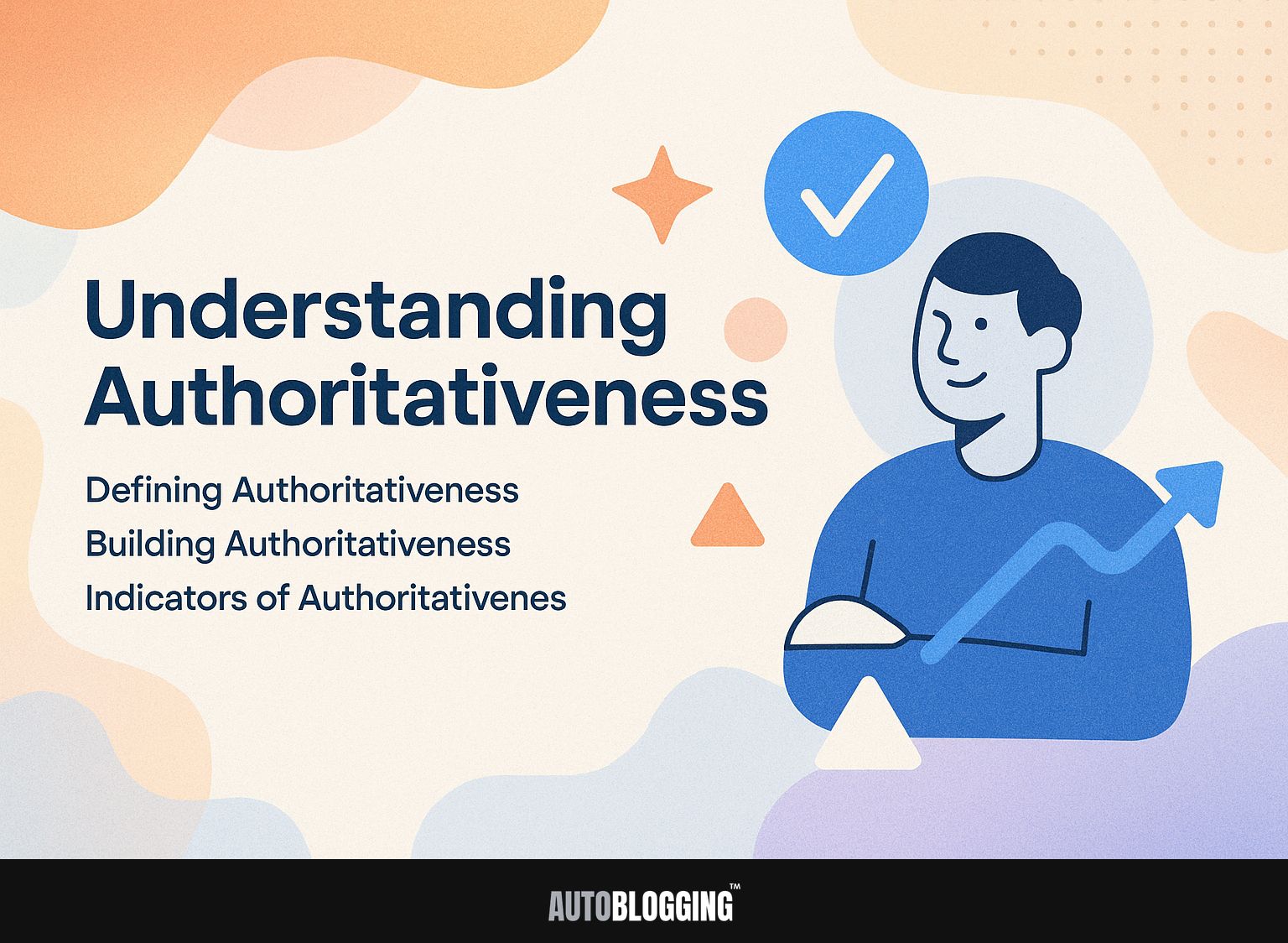
1. Defining Authoritativeness
Authoritativeness is defined as the level of respect and acknowledgment an author or website receives from both peers and users.
Improving this view can be done by using planned backlinking and citations. For example, a website like Amazon shows it is trustworthy by using links from reliable sources, such as industry publications and academic journals. This increases its credibility and attracts visitors.
To build similar authority, focus on obtaining backlinks from well-regarded websites in your niche. Use tools like Ahrefs or SEMrush to identify potential sites for outreach.
Engage in guest blogging or create shareable content that addresses current industry trends, encouraging others to link to your work.
2. Building Authoritativeness
Building authoritativeness involves a strategic approach, including acquiring backlinks, guest posting, and engaging in digital PR efforts.
To improve your credibility, begin by finding respected websites in your field where you can contribute guest posts. Tools like BuzzSumo can help pinpoint popular blogs.
Aim for 2-3 guest posts monthly, ensuring each piece includes links back to your site. Use digital PR by writing press releases for important news and sharing them through platforms like PRWeb.
Make sure to focus on social media; connect with industry leaders on Twitter and LinkedIn to build relationships and raise your profile.
3. Indicators of Authoritativeness
Key indicators of a website’s credibility include the quantity and quality of backlinks, social media endorsements, and recognition within its field.
To assess these indicators, consider using tools like Moz for Domain Authority, which gauges the strength of a site’s backlink profile on a scale from 1 to 100.
Ahrefs provides a similar feature, offering a detailed breakdown of both ‘Referring Domains’ and ‘Backlinks’.
Social proof can be evaluated by checking engagement metrics on platforms like LinkedIn and Twitter, where followers and shares demonstrate credibility.
Google Awards or industry recognitions can serve as significant endorsements, enhancing reputation and trustworthiness.
Understanding Trustworthiness
Trustworthiness is an essential part of E-A-T, showing how much users feel a website’s content is safe and reliable. A deeper understanding of trust metrics, such as Trust Flow, can significantly enhance your site’s credibility.
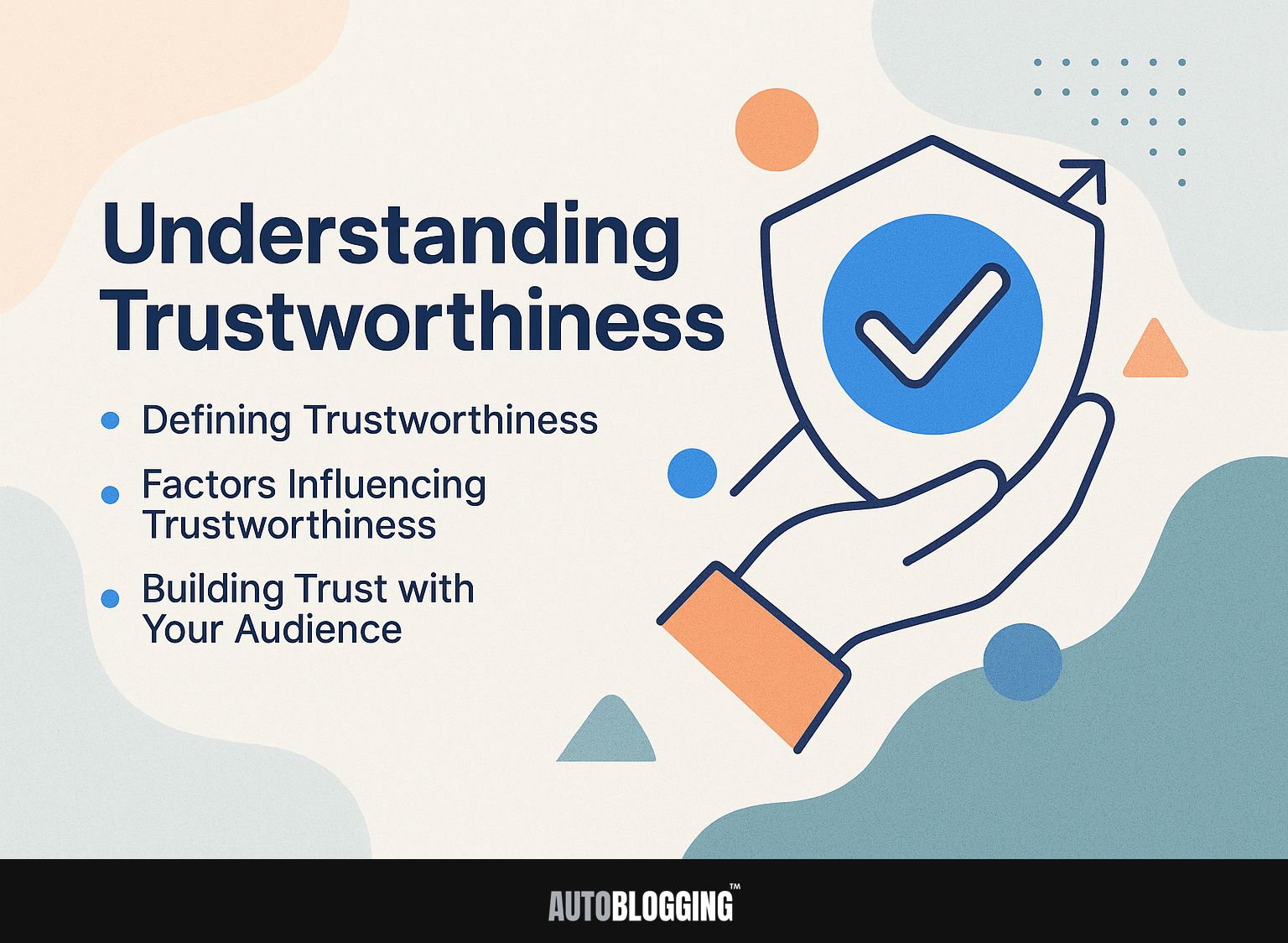
1. Defining Trustworthiness
Trustworthiness is characterized by the accuracy of content, transparent operations, and how well a site protects user data.
Establishing trustworthiness requires concrete actions. First, make sure all information is correct by checking facts before you publish, just like how Britannica reviews their content.
Second, provide clear privacy policies and cookie usage disclosures to inform users about data handling, a practice echoed by platforms such as Google.
User feedback is important; using comment or rating systems, such as Yelp, creates a feeling of community and responsibility.
By adopting these strategies, websites can build and sustain user confidence while promoting ethical online practices.
2. Factors Influencing Trustworthiness
Multiple factors influence a site’s trustworthiness, including site security measures, transparency, and user feedback mechanisms.
To build trust, create a clear privacy policy that explains how you collect and use data. Use an SSL certificate to protect user data by encrypting it. Services like Let’s Encrypt offer free options.
Transparency can be achieved by regularly updating users about data practices and changes to policies.
Integrating user feedback tools, such as Trustpilot or Google Reviews, helps show prospective customers that existing users have positive experiences. This mix of actions can greatly improve the reliability and trust of your site.
3. Building Trust with Your Audience
Building trust with your audience requires consistent engagement, transparency, and showcasing reviews and testimonials. To build trust, make sure your website has clear contact details so visitors can easily get in touch with you.
Consider adding a dedicated testimonials page featuring user experiences, which can significantly influence potential customers. Regularly updating your content based on customer feedback also demonstrates your commitment to improvement.
For instance, if users suggest new features or services, acknowledge their input through blog posts or social media updates. This active method builds community connections and strengthens your trustworthiness, leading to better relationships with your audience.
How to Improve E-A-T
Improving E-A-T involves consistently creating good content and interacting with your audience regularly.
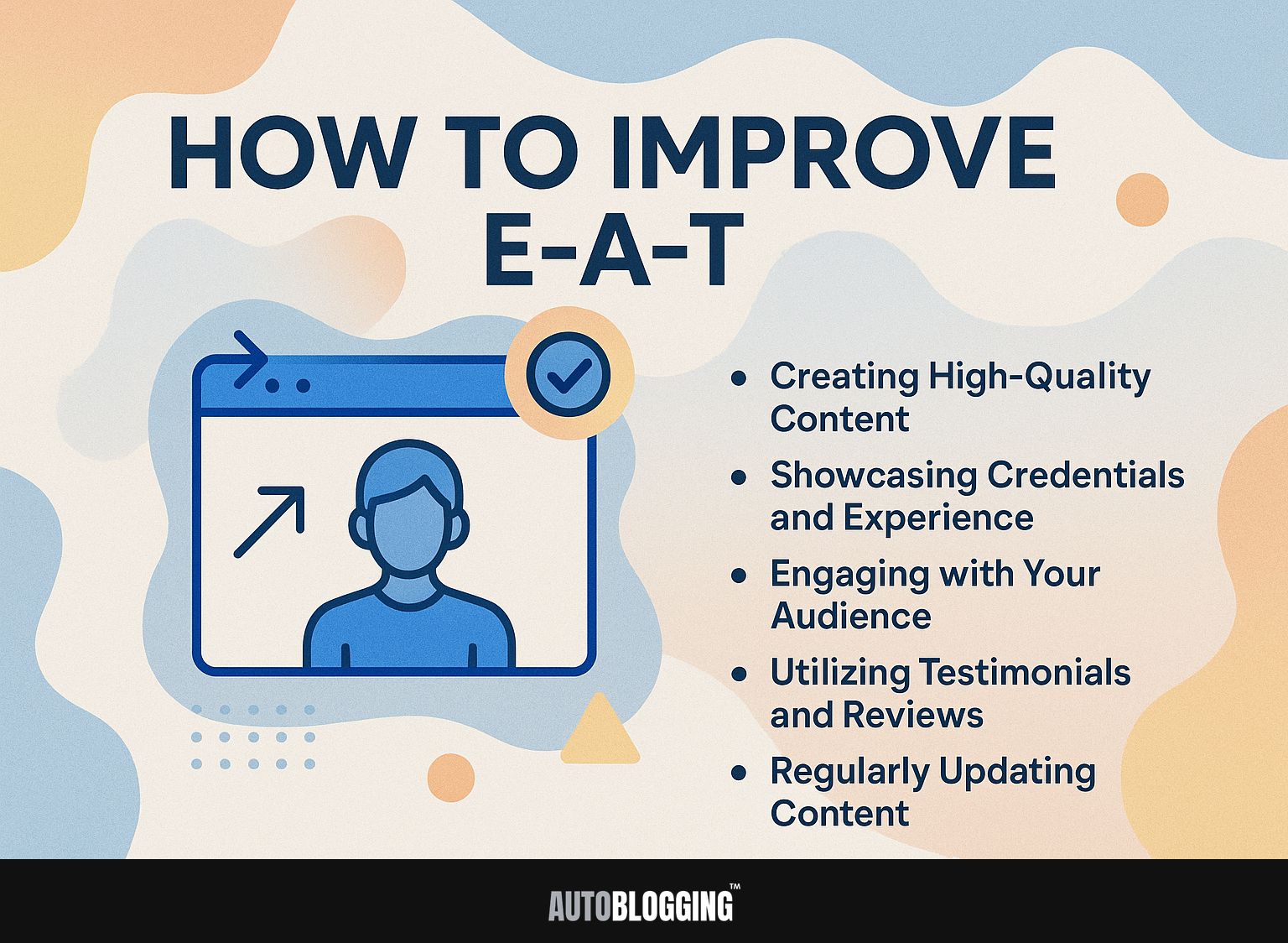
1. Creating High-Quality Content
High-quality content is characterized by depth, accuracy, and engagement, directly impacting E-A-T and search rankings.
Make sure your content matches these standards by doing detailed research. Use tools like BuzzSumo to find popular topics and Google Scholar for reliable sources.
Focus on clear writing by utilizing Grammarly for spelling and grammar checks, while the Hemingway Editor can improve readability.
Capture readers’ attention with interesting stories and appropriate images, which can be made with Canva.
Arrange your text using headings, bullet points, and images to divide sections and improve user experience, helping readers understand your information easily.
2. Showcasing Credentials and Experience
Showcasing author credentials and experience prominently helps establish credibility and solidifies user trust in the content.
To effectively showcase your credentials, consider these key strategies:
- Begin with a thorough author bio that outlines your education, relevant job history, and areas where you are knowledgeable.
- Make sure to mention any notable awards or recognitions you have received.
- Include links to your professional profiles, like LinkedIn, so readers can check and learn more about your qualifications.
- Adding a professional headshot can help build trust.
Place this information where people can find it easily, such as next to the content or in the ‘About the Author’ section.
3. Engaging with Your Audience
Interacting with your audience through comments, social media, and newsletters builds a community that increases trust and credibility.
To connect well with your audience, quickly reply to comments and handle questions or concerns openly to build a good relationship. Use social media sites like Instagram and Twitter to post polls or short questions, asking for feedback to get people involved.
To send newsletters, tools like Mailchimp allow you to send customized content, keeping subscribers updated and engaged. Consider segmenting your email lists to tailor messages based on interests, which can improve open rates and engagement.
Regularly review how your audience engages with your content so you can change your plans and keep up with their changing needs.
4. Utilizing Testimonials and Reviews
Adding testimonials and user reviews to your website helps establish trust and confirms your knowledge and credibility.
To collect testimonials effectively, consider using platforms like Trustpilot or Yotpo, which allow you to gather user feedback seamlessly.
After collecting reviews, display them prominently on your homepage or product pages using sliders or dedicated sections. It’s beneficial to include a mix of positive reviews and star ratings, as this provides a balanced view.
Consider creating case studies that examine specific user experiences, demonstrating actual results achieved with your services. This helps establish trust while attracting potential clients with success stories they can relate to.
5. Regularly Updating Content
Updating your content often keeps it correct and useful, which strengthens your site’s trustworthiness and helps it show up better in search results.
To maintain content freshness, set a quarterly review schedule. During these reviews, use tools like Ahrefs to analyze performance metrics such as page views and bounce rates.
If an article is getting less traffic, think about revising it with updated information or fresh ideas. Check for outdated links and replace them with fresh resources. This proactive approach improves SEO and makes your site a dependable source of information for users. Over time, this strategy can significantly impact your overall search rankings.
Frequently Asked Questions
1. What is E-A-T (Knowledge, Authority & Reliability)?
E-A-T means skill, credibility, and trust. It is a set of criteria used by search engines to evaluate the quality and credibility of a website or content.
2. Why is E-A-T important?
E-A-T is important because it helps search engines determine the reliability and relevance of a website or content. This can change where the website appears in search results, influencing how many people see it and trust it.
3. How does E-A-T affect SEO?
E-A-T is one of the many factors that search engines use to determine a website’s ranking. Websites with high E-A-T are more likely to rank higher in search results, which can lead to increased traffic and visibility.
4. What can I do to improve my website’s E-A-T?
To improve your website’s E-A-T, you can focus on creating high-quality, relevant, and authoritative content. This means giving precise and carefully verified details, referencing trustworthy sources, and demonstrating the skill and trustworthiness of your writers.
5. How can I showcase E-A-T on my website?
To demonstrate knowledge, credibility, and reliability on your website, you can add author bios and credentials, reference your sources, and share customer testimonials. Regular updates and upkeep of your website can improve its credibility and make it more trustworthy.
6. Does E-A-T only apply to written content?
No, E-A-T can apply to all types of content on a website, including images, videos, and audio. Make sure all your website content is high-quality and relevant to your audience to keep a strong E-A-T.
